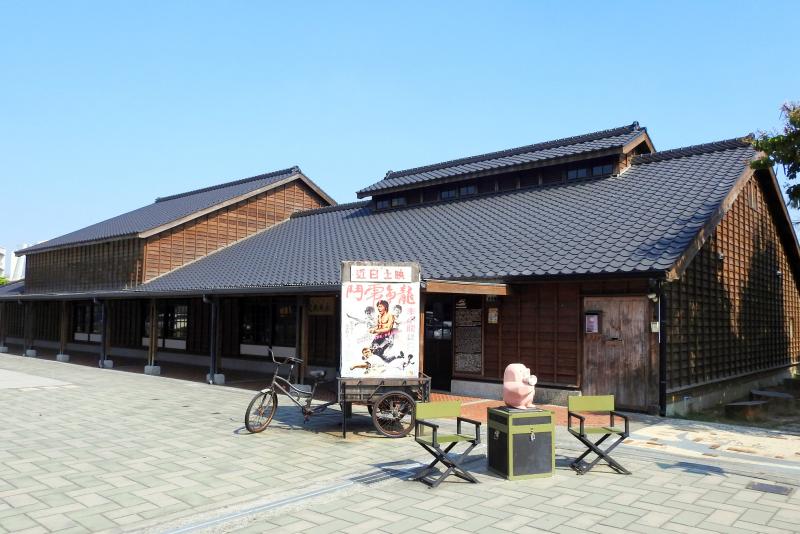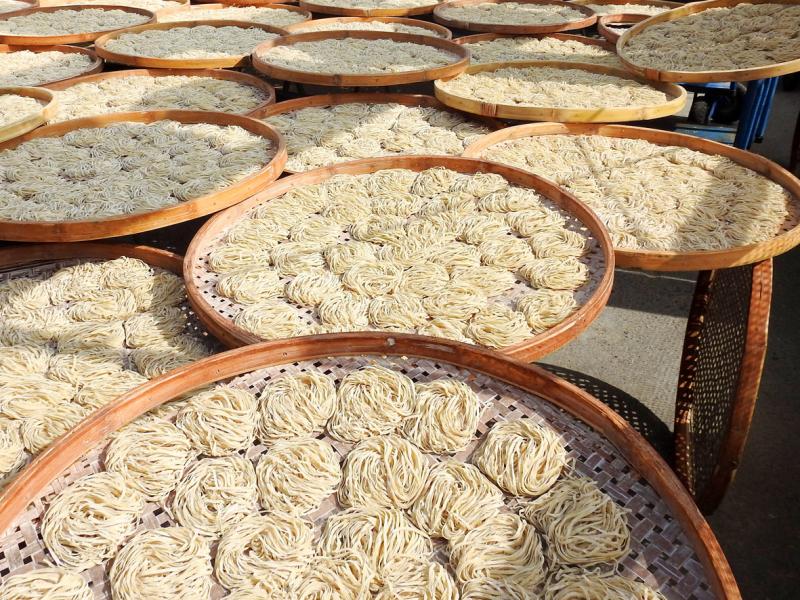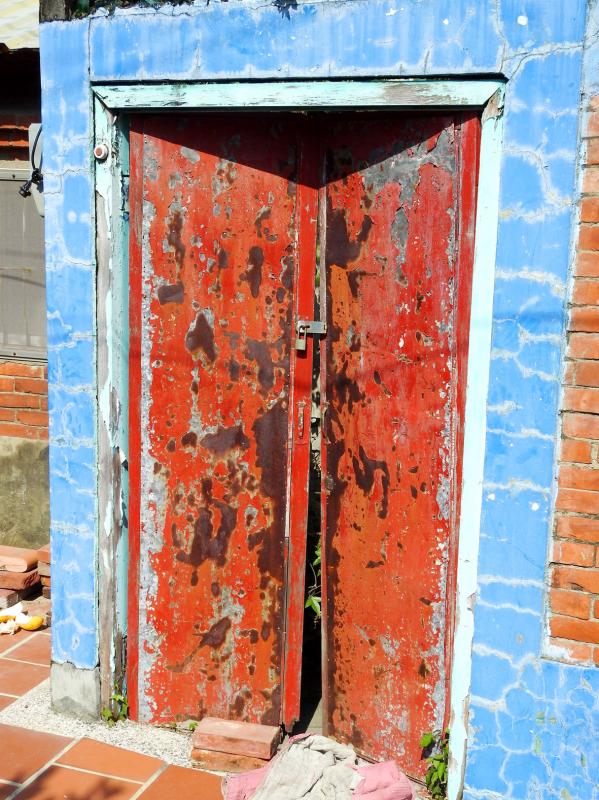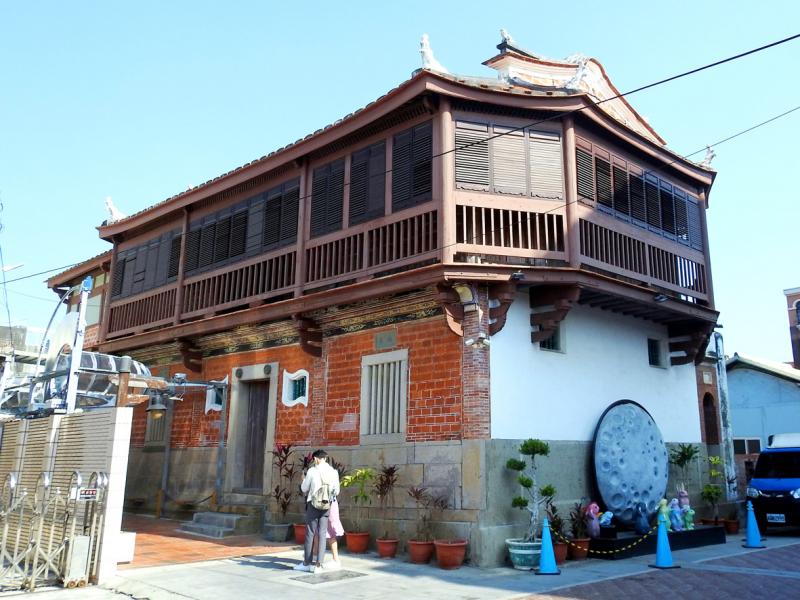It’s as if the outside world conspired to rob Yanshuei (鹽水) of its importance and prosperity.
As waterways filled with silt, access to the ocean — which had made it possible for this little town, several kilometers from the sea in the northern part of Tainan, to become a major entrepot — was lost. The north-south railway, a key driver of economic development during the 1895-1945 period of Japanese rule, never arrived. Then, in the 1970s, the sugar industry went into terminal decline.
Like Taiwan’s other old settlements, Yanshuei used to be a walled town. The defensive barrier is long gone, but there’s a reminder of the gates through which humans, horses and bullock carts entered and left in the form of street names.

Photo: Steven Crook
HISTORIC STREETS
The Martial Temple (武廟), a co-organizer of the annual Beehive Fireworks Festival (鹽水蜂炮), is at the intersection of Beimen Road (北門路, North Gate Road) and Wumiao Road (武廟路). The festival, which celebrates the end of a cholera outbreak that ravaged the town more than 130 years ago, gets its name from the fireworks holders that are positioned around the town. When the fuse on one is lit, thousands of bottle rockets screech out, much like angry bees.

Photo: Steven Crook
Yanshuei’s most interesting place of worship stands at 19 Simen Road (西門路, West Gate Road). On the outside, the Holy Trinity Catholic Church and Monastery of St Clare (鹽水天主堂) is unexceptional. Its interior, however, is captivating.
A huge depiction of the “last supper” is one of the highlights. In it, Christ and each of his apostles have Asian facial features and wear traditional Chinese garb. There are chopsticks and plates of steamed buns on the table.
Part of Nanmen Road (南門路, South Gate Road) runs parallel with Ciaonan Street (橋南街, South of the Bridge Street), one of the oldest thoroughfares in south Taiwan.

Photo: Steven Crook
Beginning my most recent walking tour of the town near Ciaonan Street, I was pleased to see that urban beautification efforts have turned what used to be Yanshuei’s docklands into an attractive green corridor. Now called Yuejingang Waterside Park (月津港親水公園), it’s certainly a pleasant spot for a picnic. But for anyone wishing to see what remains of the town’s history, it’s a very minor attraction.
On Ciaonan Street, there are several single-story houses made mainly of wood, and a few of them could be 200 years old. An unnumbered lane gives access to the backs of the buildings on the east side of the street; walking down it, I wasn’t surprised to see that some of the more traditional structures are in a very sorry state indeed.
Circling around onto the street itself, I tried to peek into No. 25. Years ago, it was the site of a small museum displaying household antiques. It looks like it could survive a few more decades, if the owners allow that. The plots on either side have been cleared.

Photo: Steven Crook
Ciaonan Street’s most famous resident is a sixth-generation blacksmith who plies his trade the old-fashioned way. At Chuan Li Blacksmith Shop (泉利鐵店) at No. 8, where his father and grandfather used to make farmers’ tools, he forges decorative items for tourists.
FAMOUS NOODLES
Lunchtime was approaching, so I did what I usually do in Yanshuei: Head for the covered food court at the intersection of Kangle Road (康樂路) and Jhongshan Road (中山路), and sit down at A-San’s Egg Noodles (阿三意麵) for a portion of the unpretentious dish that gives this decades-old eatery its name.
Like other noodle dishes in Taiwan, Yanshuei Egg Noodles (鹽水意麵) is flavored with a meat sauce assembled from small chunks of pork, a little soy sauce, some garlic and chives, and bean sprouts. The noodles are thin and flat.
A-San’s (open from 7am to 5:30pm every day except Thursday) offers both dry and soupy versions of its noodle dishes. Various side dishes are available; nothing costs more than NT$50.
While eating, I couldn’t help but notice that the food court was mostly unoccupied. Has COVID-19 caused several vendors to go out of business?
There’s a restored movie theater a stone’s throw south of the food court. Yongcheng Theater (永成戲院) was built during the Japanese period. It served as a rice mill until late 1945, when it was repurposed into a place of entertainment.
The theater was closed at the time of my visit. If you want to see the interior of this elegant landmark, visit between 1:30pm and 5:30pm on Wednesday, Thursday or Friday, or between 9:30am and 5:30pm on weekends.
Every time I’m in Yanshuei, I try to get lost in backstreets, in the hope I’ll stumble across some characterful vernacular architecture.
Sometimes, it’s just a doorway. Other times, it’s a complete house. On this occasion, it was what appeared to be a ground-up reconstruction of a traditional home on Lane 4, Minsheng Street (民生街4巷). I saw no indication that this was a government project. It’s uplifting to know there are people willing to spend their own money to retain Yanshuei’s character.
DRIFTING WESTWARD
I was also pleased to see that the Octagonal Building (八角樓) is still in excellent condition.
This landmark was constructed circa 1847 as part of a luxurious mansion for sugar magnate Yeh Kai-hung (葉開鴻). The rest of the complex is long gone, but the two-story pavilion continues to grace Jhongshan Road, between the post office and the intersection with Jhongjheng Road (中正路).
These days, because of the pandemic, visitors can only gaze at the exterior from the street. In the past, the ground floor was usually open. One time, the family who owns the building showed me around both the lower and mainly-timber upper part — and confirmed that, during the Beehive Fireworks Festival, there’s always someone at the ready with a bucket of water and a fire extinguisher, in case a smoldering bottle rocket gets lodged in the woodwork.
Continuing my westward drift, I ended up across the road from the town’s junior high school at Yanshuei Railway Station. Hold on: At the start of this article, didn’t I say that the railway never came through the town?
I did say that, and it didn’t. The station here was part of the Taiwan Sugar Corporation (台糖, TSC) rail network. Built to haul cane to sugar factories, between 1945 and 1982 the narrow-gauge system also ferried passengers between small towns and points on the north-south line.
I’d been to the station before, but had no recollection of the adjacent warehouses. These buildings lost their roofs long ago, and have been colonized by banyan trees. If you do come here, be sure to bring your camera: They’re quite a sight.
Steven Crook has been writing about travel, culture and business in Taiwan since 1996. He is the author of Taiwan: The Bradt Travel Guide and co-author of A Culinary History of Taipei: Beyond Pork and Ponlai.

This is the year that the demographic crisis will begin to impact people’s lives. This will create pressures on treatment and hiring of foreigners. Regardless of whatever technological breakthroughs happen, the real value will come from digesting and productively applying existing technologies in new and creative ways. INTRODUCING BASIC SERVICES BREAKDOWNS At some point soon, we will begin to witness a breakdown in basic services. Initially, it will be limited and sporadic, but the frequency and newsworthiness of the incidents will only continue to accelerate dramatically in the coming years. Here in central Taiwan, many basic services are severely understaffed, and

Jan. 5 to Jan. 11 Of the more than 3,000km of sugar railway that once criss-crossed central and southern Taiwan, just 16.1km remain in operation today. By the time Dafydd Fell began photographing the network in earnest in 1994, it was already well past its heyday. The system had been significantly cut back, leaving behind abandoned stations, rusting rolling stock and crumbling facilities. This reduction continued during the five years of his documentation, adding urgency to his task. As passenger services had already ceased by then, Fell had to wait for the sugarcane harvest season each year, which typically ran from

It is a soulful folk song, filled with feeling and history: A love-stricken young man tells God about his hopes and dreams of happiness. Generations of Uighurs, the Turkic ethnic minority in China’s Xinjiang region, have played it at parties and weddings. But today, if they download it, play it or share it online, they risk ending up in prison. Besh pede, a popular Uighur folk ballad, is among dozens of Uighur-language songs that have been deemed “problematic” by Xinjiang authorities, according to a recording of a meeting held by police and other local officials in the historic city of Kashgar in

It’s a good thing that 2025 is over. Yes, I fully expect we will look back on the year with nostalgia, once we have experienced this year and 2027. Traditionally at New Years much discourse is devoted to discussing what happened the previous year. Let’s have a look at what didn’t happen. Many bad things did not happen. The People’s Republic of China (PRC) did not attack Taiwan. We didn’t have a massive, destructive earthquake or drought. We didn’t have a major human pandemic. No widespread unemployment or other destructive social events. Nothing serious was done about Taiwan’s swelling birth rate catastrophe.